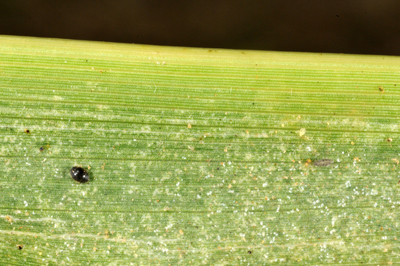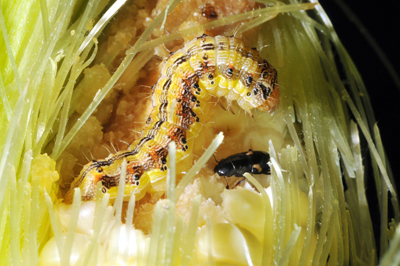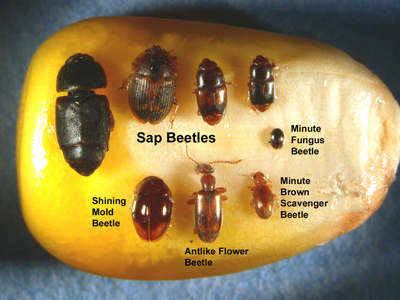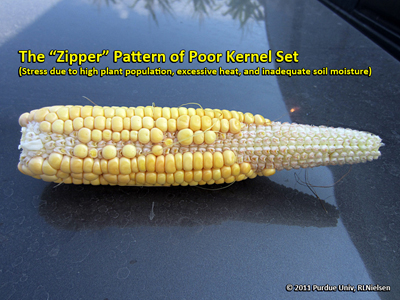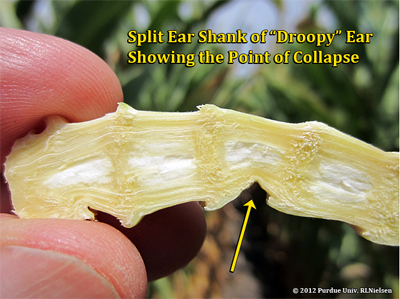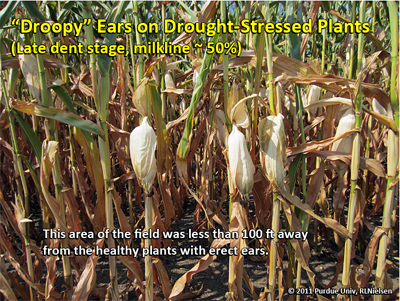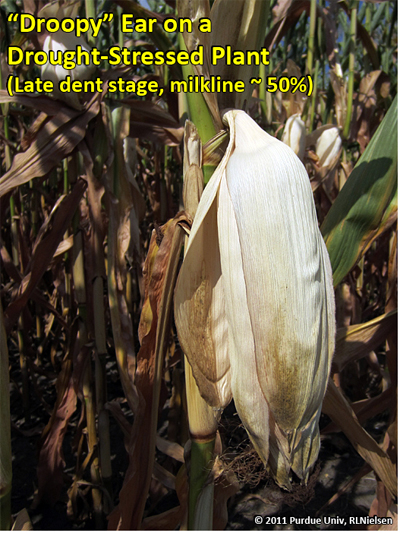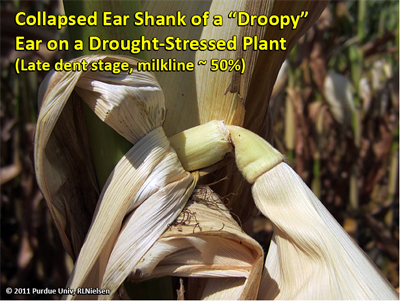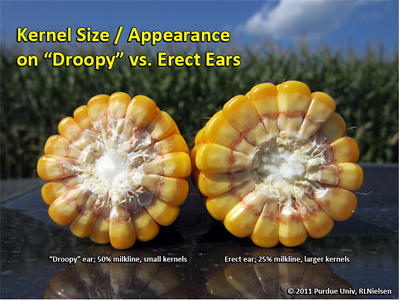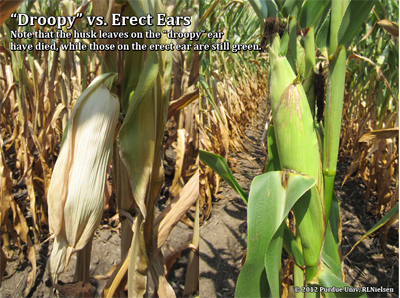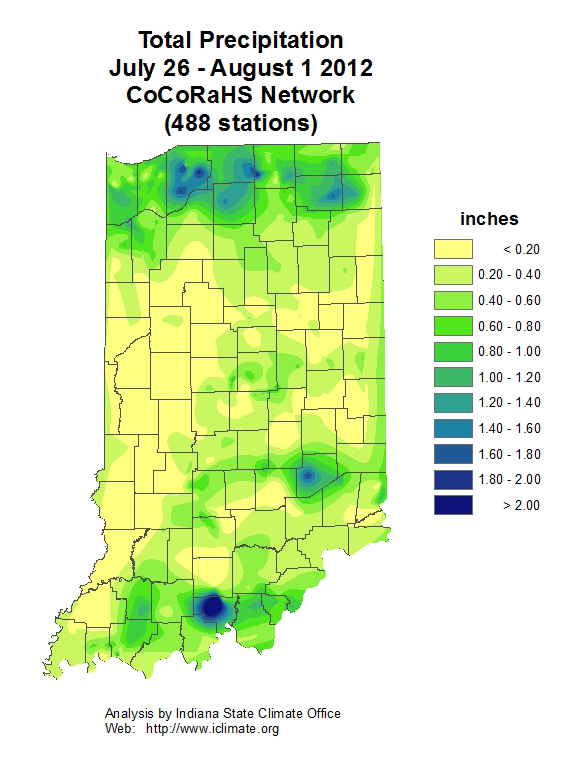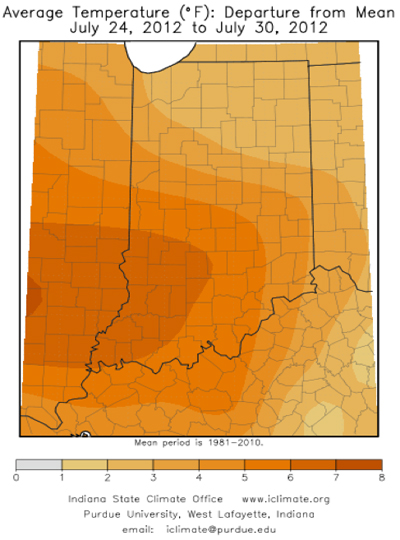Pest & Crop Newsletter, Entomology Extension, Purdue University
Spider Mites in Soybean, CORN, Trees, Flowers, Vegetables, Fruit... – (Christian Krupke and John Obermeyer) -
• Spider mites in Indiana field corn is uncommon.
• Use caution while interpreting spider mite information from western states.
• Mite species/environments vary considerably across the Corn Belt.
• While scouting, must go beyond the end rows to determine infestation.
If it’s true that “misery loves company,” then producers and homeowners can commiserate in the knowledge that spider mites are flourishing and attacking host plants of all kinds. The big difference is that producers have their livelihood at stake in these already drought-ravaged crops. There is clearly a range in how proactive producers have been in handling infestations, this is evidenced by variable severity in mite damage throughout the state. Timely treatment should pay dividends for those soybean fields that have recently gotten rains to help develop/fill pods. But, what about spider mites being found on field corn?
Levels of spider mite damage to corn leaves
Spider mite damage in field corn is a rarity in the Eastern Corn Belt, and very little is understood about their potential effect on yield in the Midwest. Most have been pulling information, via online newsletters, from Texas, Kansas, Colorado, and Nebraska for information on yield impacts and treatment decisions. Chemical companies have sent “educational” emails, giving efficacy results from these states out west for their products. We too are on a steep learning curve, but as we visit with, or read our colleagues information out west, we feel that we’re comparing apples to oranges. Mite species and humidity levels are two of the glaring differences.
Two-spotted spider mites (Tetranychus urticae) are our enemy in field crops (and in many homeowner and greenhouse plants), while out in the Western Corn Belt, their primary species is the Bank’s grass mite (Oligonychus pratensis) with some two-spotted mites mixed in. There are several subtle differences in identification, biology, and damage between the two species, but the primary one being two-spotted is less susceptible to pesticides. In addition, two-spotted is prone to building pesticide resistant populations. In short, we’ve got the tougher pest. And because of that, pesticide carrier volumes are recommended to be increased to at least 5 gpa by air and 20 gpa by ground.
Ear leaf showing slight spider mite stippling, indicating colonization
Though we have gone through “Texas-like” weather for many weeks of May, June and some of July, we certainly are in a different weather pattern now. Though not all areas of the state are getting rainfall, see weekly rainfall maps of this and past Pest&Crop issues, all counties have higher humidity. Though high humidity (>50%) doesn’t stop spider mites, it certainly slows down water loss from plants, and therefore lowers plant stress and mite reproductive rates. It also makes mite populations prone to epizootics (“plagues” of fungal disease).
Close-up of spider mites and their stippling damage to corn leaf
Spreading through a cornfield is not as easy for spider mites as in soybeans. Mites can either walk from plant to plant via touching leaves or they “balloon” with spun webs, allowing the wind to transport them. Certainly this must be a slow process, because wind movement in the lower canopy of cornfields is quite limited. One must make certain that spider mites have moved beyond the end rows, walking well into the field to determine their presence and colonization of leaves is crucial.
There are many natural enemies of spider mites, pictured here is a spider mite destroyer (tiny lady beetle) adult and larva
We still remain doubtful that spider mite treatments in yellow-dent corn are warranted. However, if fields with decent yield potential (100+ bu/a) have spider mite colonies established on lower leaves (discolored), and spreading to the ear leaf or above, then treating before the dent stage may be justified. As previously mentioned, high amount of carrier (5 by air, 20+ by ground) is strongly recommended. Consider that spider mites are usually most actively colonizing the underside of lower leaves so canopy penetration is necessary. We have no experience to draw from in treating corn for spider mites, but we would suggest dimethoate or propargite (Comite) as first choices. Chlorpyrifos is labeled for corn, but spider mite is not a targeted pest.
![]()
Picnic Beetles in Corn Ears - (John Obermeyer)
It is obvious folks are out looking at corn ears to determine the damage done by the drought. Some have found “picnic beetles” or other small brownish beetles feeding on kernels in tips of ears. These are also often called “beer bugs.” The family of insects, Nitidulidae, has a range of size and colored beetles that are attracted to fermenting organic matter (alcohol!) and this is the reason they turn up in your beer. Their presence is in response to previous damage to those upper kernels, which includes insect (e.g., western bean cutworm) and/or bird feeding. In addition, hybrids with short ear husks seem to be more prone to exposing kernels, making easy access for rootworm and Japanese beetles to compromise ear tip kernels while feeding on silks. Please don’t waste time and effort considering treating fields for these opportunistic insects, as what they eat wouldn’t make it through the harvest process.
Picnic beetle feasting on earworm leftovers
Assortment of sap and mold beetles that could be found in the ear of damaged kernels
![]()
Click here for the Blacklight Trap Catch Report
![]()
Click here for the Western Bean Cutworm Trap Report
Begin Scouting for Aspergillus Ear Rot – (Kiersten Wise and Charles Woloshuk) - Symptoms of Aspergillus ear rot have been reported in corn in southern Indiana. Weather conditions have been favorable for Aspergillus ear rot development and producers should plan to scout fields to determine if this ear rot is present. This ear rot is caused by the fungus Aspergillus flavus, which produces a mycotoxin known as aflatoxin. Aflatoxin is a very toxic carcinogen, and livestock that consume contaminated grain or silage may be at risk for many health problems. Two weeks ago we released an article describing how to scout for and identify Aspergillus ear rot, test for aflatoxin, and harvest and store affected grain. Please refer to the article: “Preparing for Aspergillus ear rot in corn grain and silage” for more information.
![]()
Fungicide Applications in Soybean—Risk vs. Reward – (Kiersten Wise) -
Soybeans are beginning to form pods (R3) in Indiana, and farmers are deciding whether or not to apply fungicides to soybean in the hopes of increasing or protecting yield. Currently there is low foliar disease pressure in Indiana soybeans, and our standard recommendation is that fungicides should be applied only when foliar disease pressure is potentially yield-limiting. However, many growers are interested in applying fungicides for other benefits, including improving water use efficiency, and retention of green leaf area which may lead to an extended period of seed fill and higher yields. This question was addressed recently in an article released by the University of Illinois: “Do Dry-Weather Crops Still Need Fungicides” by Dr. Carl Bradley: <http://bulletin.ipm.illinois.edu/article.php?id=1689>. In this article, Dr. Bradley summarizes soybean fungicide trials across Illinois and found that a yield benefit from a fungicide application was not observed on soybeans grown under very water-stressed conditions.
Similarly, published research that examines the effects of strobilurin fungicides on water use efficiency found that strobilurin fungicides could slightly increase water use efficiency in well-watered plants, but both water-use efficiency and photosynthesis were reduced in water-stressed plants. These research results indicate that fungicides applied to drought-stressed plants may actually have a negative impact on plant physiological processes. See the following article for more information on this study: Nason, M.A., J. Farrar, and D. Bartlett. 2007. Strobilurin fungicides induce changes in photosynthetic gas exchange that do not improve water use efficiency of plants grown under conditions of water stress. Pest Management Science 63:1191-1200.
Economic analysis of two years of soybean fungicide research data across six sites in Indiana from 2009 to 2011 indicate that fungicide applications do not consistently result in a profit if they are applied in the absence of disease, even under adequate moisture for the crop.
Table 1 shows the average net returns for treatments applied to soybean from 2009 to 2011. Our soybean management program in these trials consisted of 22 fl oz glyphosate at growth stage V3 or R2, 6 fl oz of the strobilurin fungicide Headline® fungicide at R2 or R4, and 3 fl oz of the insecticide Warrior® at R4. Trials were rated for disease and insect pressure throughout the season; however, no significant pressure was found in any trial location in any year. Economic analysis was calculated based on the five-year historical soybean price, yield data from the aforementioned study, and averaged pesticide costs for 2011-12. Prices for input costs are based on estimates from the 2011 Purdue Crop Cost & Return Guide (ID-166-W). The net returns do not include factors such as rent, taxes, labor, premiums, etc. The economic analysis software SIMETAR was used to generate this data.
| Table 1. Net returns for soybean fungicide and insecticide treatments from 2009 to 2011 in Indiana. | ||
| Treatment | Timing | Mean Return ($/Acre) |
| Glyphosate | Standard | $435 |
| Glyphosate followed by Headline | R2 | $406 (-29) |
| Glyphosate followed by Headline | R4 | $420 (-15) |
| Glyphosate followed by Warrior | R4 | $385 (-50) |
| Glyphosate followed by Headline followed by Warrior | R2 fb R4 | $381 (-54) |
| Glyphosate followed by Headline + Warrior | R4 | $384 (-51) |
The highest return per acre was obtained with a standard weed management program. Additional inputs did not consistently provide an economic benefit when compared to the potential net returns from the standard glyphosate program.
The bottom line is that growers who are applying fungicides in the absence of disease and/or for physiological benefits should manage expectations about yield increases that may result from these fungicide applications. Although 2012 soybean prices are at record highs, and the ability to break-even on the cost of a fungicide application may be as low as one bushel/acre, research data indicate that applications to water-stressed plants may not increase yield, and that fungicide applications are not always profitable, even under less water-stressed conditions.
Opportunities to Assess Yield Potential of Drought-Stressed Corn – (Bob Nielsen) -
As the Great Drought of 2012 continues to wreak havoc with the corn crop throughout Indiana and elsewhere in the Midwest, there are several opportunities to assess the yield potential of individual damaged fields. In “normal” years, I would tell growers that the simple plant/ear/kernel count method for estimating grain yield prior to harvest (Nielsen, 2011b) is probably all they need to do to estimate the relative yield potential of their fields. However, the severity, duration, and variability of the stress of the current drought ranks among the worst in recent Indiana history. Combined with the additional stress imposed by days of excessively high temperatures, the consequences are already severe in many fields and will yet become so in more fields in the coming weeks.............. All at a point in the growing season that is way earlier than the traditional kernel count method was designed for.
Clearly, the yield potential of fields whose plants are already dead is pretty easy to determine. The more uncertain situations are those fields that appear to be less than disastrous based on windshield surveys.
1st Opportunity: In another article (Nielsen, 2012), I described the “ear shake” technique that can be used to assess the success or failure of pollination. Normally, this technique falls into the category of “casual interest” because the pollination process is usually not a problematic issue. However, this year the combination of severe drought and excessive heat during pollination has seriously compromised that process in quite a few fields. The “ear shake” technique can be used as early as 5 to 6 days after silks are pollinated by pollen and, thus, represents an early assessment of relative yield potential; i.e., good, bad, or in between. Most of Indiana’s corn crop is beyond this point, but there are a few fields just now attempting to pollinate or have recently pollinated, so there may be a few opportunities to use this method yet this season.
Ear with majority of silks detached, indicating nearly complete ovule fertilization
2nd Opportunity: Even if pollination occurred successfully, subsequent severe drought and excessive heat can cause significant kernel abortion throughout the developing ear during the blister and milk stages of kernel development (Nielsen, 2008). The younger kernels on an ear are most susceptible to photosynthetic stress and thus are at most risk of kernel abortion.
Much of the state’s corn crop is still in this vulnerable stage of kernel development with only 22% of the crop statewide estimated to have reached the dough stage of kernel development as of 22 July (USDA-NASS, 2012). This fact is also why rainfall now may indeed have dramatic benefits to the corn crop if it prevents significant rates of kernel abortion.
Poor kernel set due to unsuccessful fertilization of ovules by pollen
Combination of pollination failure and kernel abortion
With “normal” stress following pollination, kernel abortion typically occurs near the tip of the developing ear because those kernels are usually younger. Silks from those ovules usually emerge later than those from the ovules lower on the cob and, thus, are last to be fertilized by pollen. When severe stress exists prior to and during pollination, silk emergence may be somewhat more random or pollen fertilization more erratic. Consequently, kernel “age” may be more random throughout the ear and kernel abortion thus also more random in its pattern (Nielsen, 2011c; Nielsen, 2011d). Assessing the degree of kernel abortion shortly after the milk stage of development can help you assess relative yield potential; i.e., good, bad, or in between.
3rd Opportunity: The last opportunity to assess yield potential prior to harvest is near physiological maturity (kernel black layer, Nielsen, 2008) using the so-called yield component method (Nielsen, 2011b). Technically, you can use this method at the dough or dent stages of kernel development, but waiting until physiological maturity allows you to assess kernel depth (aka size or weight). This allows you to “fine-tune” the yield estimate by tweaking the kernel weight “fudge factor” in the formula. Even so, this yield estimation method probably is no more accurate than about 20-30 bu/ac.
Recognize that estimates of grain yield under drought conditions are difficult at best because of the challenge of assessing the spatial variability for drought stress within fields. It is not easy or enjoyable to thoroughly walk a large field to collect reliable ear samples. However, any opportunity to assess yield potential of stressed fields will help identify the severity of the yield losses and may help you modify your grain marketing decisions this fall.
The zipper pattern of poor kernel set
Related Reading
Nafziger, Emerson. 2012. Estimating Yields of Stressed Corn. The Bulletin, Univ of Illinois. <http://bulletin.ipm.illinois.edu/article.php?id=1695> [URL checked July 2012].
Nielsen, RL (Bob). 2008. Grain Fill Stages in Corn. Corny News Network, Purdue University. <http://www.agry.purdue.edu/ext/corn/news/timeless/grainfill.html>. (URL checked July 2012).
Nielsen, RL (Bob). 2011a. Effects of Stress During Grain Filling in Corn. Corny News Network, Purdue Extension. <http://www.kingcorn.org/news/timeless/GrainFillStress.html> [URL checked July 2012].
Nielsen, RL (Bob). 2011b. Estimating Corn Grain Yield Prior to Harvest. Corny News Network, Purdue University. <http://www.agry.purdue.edu/ext/corn/news/timeless/YldEstMethod.html>. (URL checked July 2012).
Nielsen, RL (Bob). 2011c. Kernel Set Scuttlebutt. Corny News Network, Purdue Extension. <http://www.kingcorn.org/news/timeless/KernelSet.html>. [URL checked July 2012].
Nielsen, RL (Bob). 2011d. The “Zipper” Pattern of Poor Kernel Set in Corn. Corny News Network, Purdue Extension. <http://www.kingcorn.org/news/timeless/Zipper.html>. [URL checked July 2012].
Nielsen, RL (Bob). 2012. A Fast & Accurate Pregnancy Test for Corn. Corny News Network, Purdue University. <http://www.agry.purdue.edu/ext/corn/news/timeless/EarShake.html>. (URL checked July 2012).
![]()
Do Your Ears Hang Low? (Premature Ear Declination in Corn) – (Bob Nielsen) - Split ear shank of droopy ear showing the point of collapse
Droopy ears on drought-stressed plants Droopy ear on a drought-stressed plant
Collasped ear shank of a droopy ear on a drought-stressed plant
The timing of the onset of the collapsed ear shanks determines the magnitude of the expected yield loss. If grain fill were totally shut down at the full dent stage of grain development (milk line barely visible at dent of kernels), the yield loss would be as much as 40 percent. If grain fill were totally shut down at the late dent stage of grain development (milk line halfway between dent and tip), yield losses for the affected ears would equal about 12 percent. Kernel size/appeearance on droopy vs erect ears
Droopy vs. erect ears
Droopy ears are cute on certain breeds of dogs, but droopy ears on corn plants prior to physiological maturity are a signal that grain fill has slowed or halted. Ears of corn normally remain erect until some time after physiological maturity (black layer development) has occurred, after which the ear shanks eventually collapse and the ears decline or “droop” down. The normal declination of the ears after maturity is desirable from the perspective of shedding rainfall prior to harvest and avoiding re-wetting of the grain. Premature ear declination, however, results in premature black layer formation, lightweight grain, and ultimately lower grain yield per acre.
What Causes Premature Droopy Ears? The most common contributing factor seems to be severe drought stress that extends late into the grain filling period. The “droopy” symptom suggests a loss of turgidity in the ear shank with stress, possibly combined with some cannibalization of the ear shank similar to what can occur with the stored reserves of the main stalk in response to severe photosynthetic stress. Eventually, the ear shank collapses and the ear droops down.
Flashback: In hybrids without the Bt-corn borer trait, collapsed ear shanks can also result from extensive tunneling by European corn borer larvae. Such tunneling weakens the ear shank, allowing it to collapse, and can ultimately also cause the ear to literally drop from the plant.
Impact on Yield? Remember that the ear shank is the final “pipeline” for the flow of photosynthates into the developing ear. An ear shank that collapses prior to physiological maturity will greatly restrict, if not totally prevent, the completion of grain fill for that ear and will likely cause premature black layer development in the grain. If the droopy ears you’ve looked have not yet black layered, they will black layer prematurely; sooner than neighboring erect ears.
Multiplying the percentage of affected ears in a field by the estimated yield loss per ear will give you an estimate of whole field loss. For example, if ten percent of the field contained plants whose ears drooped prematurely at the late dent stage, whole field loss would be estimated at 1.2 percent (10 percent of the ears multiplied by 12 percent yield loss per ear).
Final thought: While it is never enjoyable assessing the yield potential of drought-stressed fields, it does serve a purpose in helping you develop your grain marketing strategy. Let this article serve as a reminder that the proverbial “windshield survey” often fails to provide an accurate assessment of crop condition.
Related Reading
Nielsen, RL (Bob). 2008. Grain Fill Stages in Corn. Corny News Network, Purdue University. <http://www.agry.purdue.edu/ext/corn/news/timeless/grainfill.html>. [URL checked July 2012].
Nielsen, RL (Bob). 2012. Opportunities to Assess Yield Potential of Drought-Stressed Corn. Corny News Network, Purdue Univ. <http://www.kingcorn.org/news/articles.12/YldAssessment-0727.html> [URL checked Aug 2012]. ![]()




